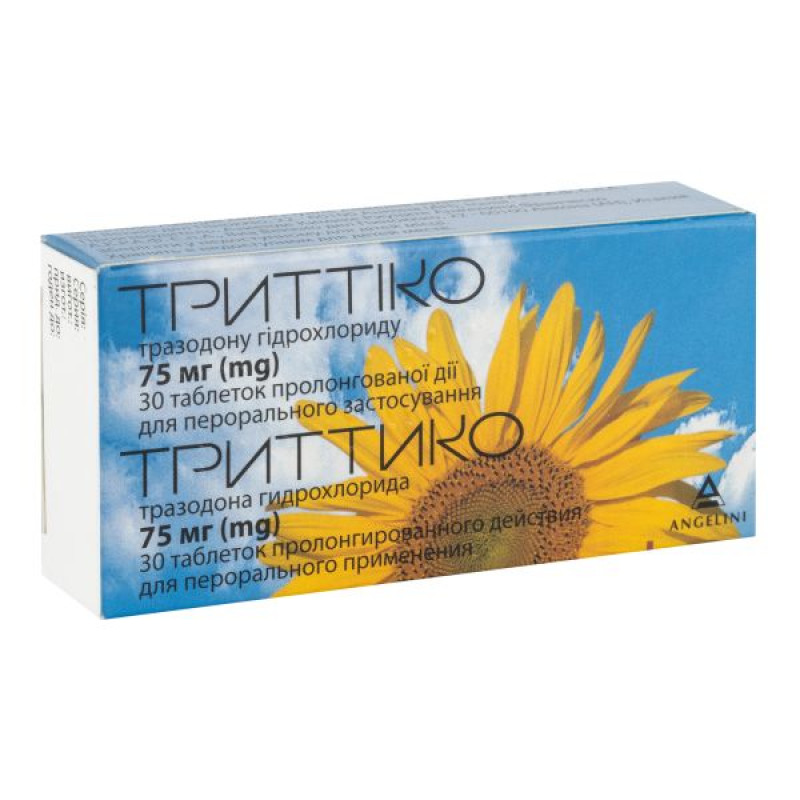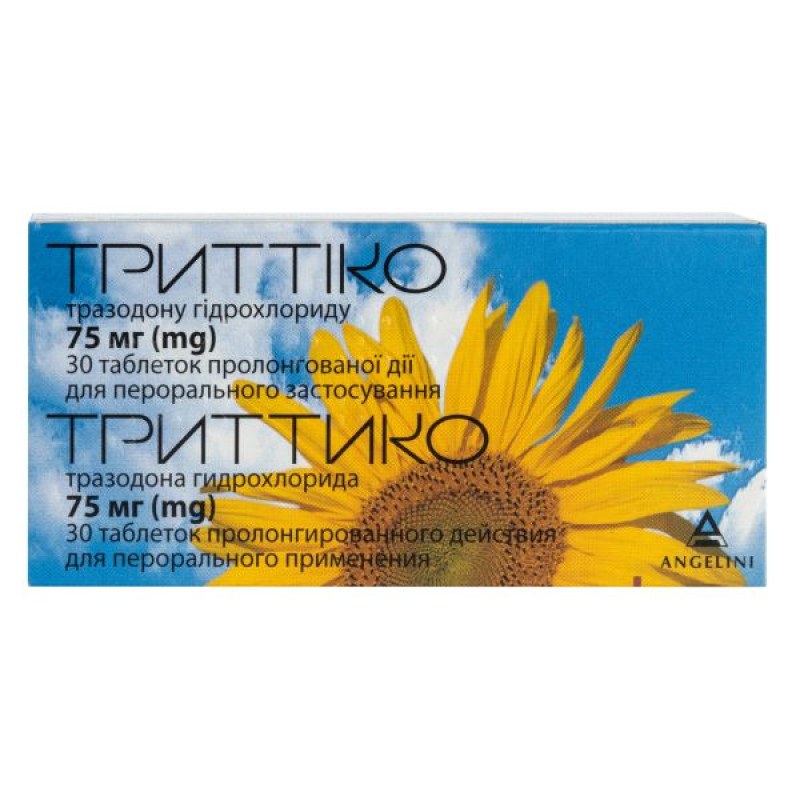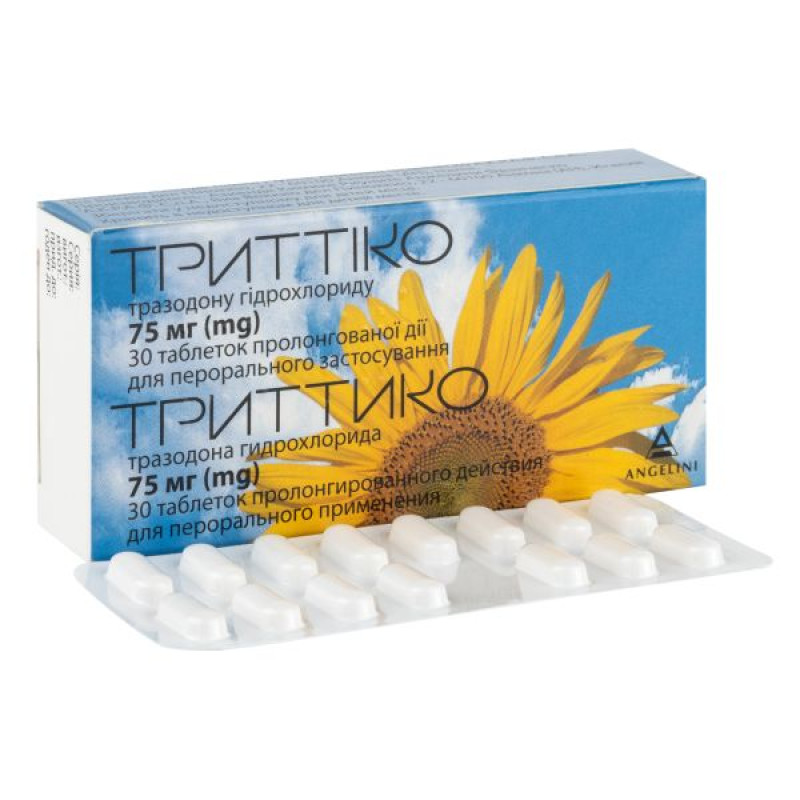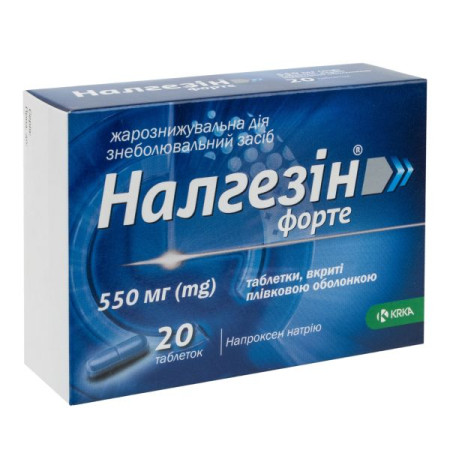Trittico prolonged-release tablets 75 mg blister No. 30

Instructions for Trittico prolonged-release tablets 75 mg blister No. 30
Composition
active ingredient: trazodone hydrochloride;
1 tablet contains trazodone hydrochloride 75 mg or 150 mg;
excipients: sucrose, carnauba wax, povidone, magnesium stearate.
Dosage form
Extended-release tablets.
Main physicochemical properties:
75 mg tablets: biconvex, oblong tablets, white to yellowish-white in color, with two scores on both sides;
150 mg tablets: biconvex, oblong tablets, white to yellowish-white in color, with two scores on both sides.
Pharmacotherapeutic group: Psychoanaleptics. Antidepressants. Other antidepressants. ATC code: N06A X05.
Pharmacological properties
Pharmacodynamics
Trazodone is a triazolopyridine derivative. It is effective in the treatment of depressive states, including depression associated with anxiety and sleep disturbances, and is characterized by a rapid onset of action (about 1 week).
Trazodone is a serotonin reuptake inhibitor and 5-HT2 receptor antagonist, the activation of which is usually associated with the appearance of insomnia, anxiety, psychomotor agitation, and changes in sexual function.
Unlike other psychotropic drugs, trazodone is not contraindicated in glaucoma and urinary disorders, it has no extrapyramidal effects and does not potentiate adrenergic transmission. Trazodone is devoid of anticholinergic activity, therefore it does not exhibit the effects on cardiac function typical of tricyclic antidepressants.
Pharmacokinetics
After a single oral dose of 75 mg of trazodone extended-release, the maximum plasma concentration (Cmax) is about 0.7 μg/ml and is reached at a Tmax of 4 hours; the area under the pharmacokinetic curve (AUC) is about 8 μg/ml/h. After a single oral dose of 150 mg of trazodone extended-release, the Cmax is about 1.2 μg/ml and is reached at a Tmax of 4 hours. The half-life is about 12 hours and the AUC is about 18 μg/ml/h.
Food interaction studies have shown no significant changes in Cmax and AUC when Trittico prolonged-release tablets are administered on an empty stomach or after a meal.
In vitro studies with human liver microsomes have shown that trazodone is metabolized primarily by cytochrome P450 3A4 (CYP3A4).
Trazodone is excreted mainly in the urine as its metabolites.
Indication
Depressive disorders with/without anxiety.
Contraindication
Known hypersensitivity to the drug or its components.
Alcohol intoxication and intoxication with sleeping pills.
Acute myocardial infarction.
Interaction with other medicinal products and other types of interactions
General
The sedative effects of antipsychotics, hypnotics, anxiolytics and antihistamines may be enhanced. A reduction in the dose of these agents is recommended.
Oral contraceptives, phenytoin, carbamazepine, and barbiturates, due to their effects on the liver, accelerate the metabolism of antidepressants. Cimetidine and some other antipsychotics slow down the metabolism of antidepressants.
CYP3A4 inhibitors
In vitro drug metabolism studies suggest the potential for drug interactions when trazodone is coadministered with CYP3A4 inhibitors such as erythromycin, ketoconazole, itraconazole, ritonavir, indinavir and nefazodone. The use of CYP3A4 inhibitors is likely to result in significant increases in trazodone plasma concentrations. In vivo studies in healthy volunteers have shown that after coadministration of ritonavir 200 mg twice daily, trazodone plasma levels increased more than 2-fold, resulting in nausea, syncope and hypotension. Therefore, a reduction in the trazodone dose may be appropriate when coadministering trazodone with a potent CYP3A4 inhibitor.
However, if possible, the concomitant use of trazodone and potent CYP3A4 inhibitors should be avoided altogether.
Carbamazepine
When trazodone is used simultaneously with carbamazepine, the plasma concentrations of trazodone are reduced. When used simultaneously with carbamazepine at a dose of 400 mg per day, the plasma concentrations of trazodone and its active metabolite m-chlorophenylpiperazine were reduced by 76% and 60%, respectively. The patient should be carefully monitored for the need to increase the dose of trazodone.
Tricyclic antidepressants
There is a risk of drug interactions, so concomitant use with trazodone should be avoided. In case of concomitant use, the development of serotonin syndrome and adverse reactions from the cardiovascular system should be expected.
Fluoxetine
Rare cases of increased trazodone plasma levels and adverse effects have been reported when trazodone was co-administered with fluoxetine (a CYP1A2/2D6 inhibitor). The mechanism underlying this pharmacokinetic interaction is not fully understood. A pharmacodynamic interaction (serotonin syndrome) cannot be excluded.
There have been isolated reports of interactions between trazodone and MAO inhibitors. Although some physicians practice concomitant use of these agents, it is not recommended to use trazodone concomitantly with MAO inhibitors or within 2 weeks of their discontinuation. It is also not recommended to start MAO inhibitor therapy within 1 week of trazodone discontinuation.
Phenothiazines
Cases of severe orthostatic hypotension have been observed with concomitant use of phenothiazines, such as chlorpromazine, fluphenazine, levomepromazine, perphenazine.
Anesthetics/muscle relaxants
Trazodone hydrochloride may potentiate the effects of muscle relaxants and volatile anesthetics. Such combinations should be used with caution.
Alcohol
The sedative effects of alcohol are more pronounced under the influence of trazodone. The patient should avoid drinking alcohol during treatment with trazodone.
Levodopa
Antidepressants can accelerate the metabolism of levodopa.
Other means
The risk of ventricular arrhythmias, including torsade de pointes, may be increased when trazodone is used concomitantly with drugs known to prolong the QT interval. These drugs should be used with caution when used concomitantly with trazodone.
Trazodone is only a very weak inhibitor of norepinephrine reuptake and does not affect the blood pressure response to tyramine therapy, so trazodone should not be expected to affect the hypotensive effects of guanethidine-like compounds. However, studies in laboratory animals have shown that trazodone can inhibit most of the rapid effects of clonidine.
Although no drug interactions have been reported when other types of antihypertensive drugs are used concomitantly with trazodone, the possibility of potentiation of effects should be considered.
The frequency of undesirable effects may increase when trazodone is used concomitantly with preparations containing St. John's wort (Hypericum perforatum).
Oral anticoagulants and/or antiplatelet agents: Interactions with anticoagulant effect (laboratory abnormalities and/or clinical signs and symptoms) with increased bleeding have been reported rarely.
Cases of changes in prothrombin time values have been reported in patients receiving trazodone and warfarin concomitantly.
Serum levels of digoxin or phenytoin may be increased when these agents are administered concomitantly with trazodone. Serum levels of these agents should be monitored in patients receiving such therapy.
Application features
Use in children and adolescents
Trazodone should not be used in children and adolescents. In a clinical trial in children and adolescents, suicidal behavior (suicide attempt and suicide planning) and hostility (predominantly aggression, oppositional behavior, and anger) were more frequently observed in the antidepressant group than in the placebo group. In addition, there are currently no data on the long-term safety of the drug in children and adolescents, given its effects on growth, puberty, and cognitive and behavioral development.
Suicide/suicidal thoughts or clinical worsening
Depression is associated with an increased risk of suicidal thoughts, self-harm and suicide (suicidal behavior). This risk persists until significant remission occurs. No improvement may occur during the first few weeks of therapy or longer. Patients should be closely monitored until such improvement occurs. General clinical experience indicates that the risk of suicide may be increased in the early stages of recovery.
Patients with a history of suicidal behaviour or patients who have shown a significant degree of suicidal ideation prior to initiation of therapy are known to be at greater risk of suicidal thoughts or suicide attempts and should receive close monitoring during treatment. A meta-analysis of placebo-controlled clinical trials of antidepressants in psychiatric disorders showed that among patients aged <25 years, those in the antidepressant group were at greater risk of suicidal behaviour than those in the placebo group.
Patients should be closely monitored during treatment with this drug, particularly those at high risk, especially at the beginning of treatment and after dose changes. Patients (and caregivers of patients) should be alerted to monitor for any clinical signs of worsening of their condition, suicidal behaviour or thoughts, and unusual changes in behaviour and to seek medical advice immediately if these symptoms present.
To minimize the potential risk of suicide attempts, especially at the beginning of therapy, the physician should prescribe only limited amounts of trazodone to the patient at each visit.
It is recommended to carefully select the dosage regimen and regularly monitor patients with the following conditions:
epilepsy, in particular, such patients should not sharply increase or decrease the dose;
liver or kidney dysfunction, especially severe;
heart disease, such as angina pectoris, cardiac conduction disorders or atrioventricular block of varying degrees; recent myocardial infarction;
urinary disorders, for example, in prostatic hypertrophy, although such problems are not expected, since the anticholinergic effect of trazodone is insignificant;
acute angle-closure glaucoma, increased intraocular pressure, although significant changes in the condition are not expected, since the anticholinergic effect of trazodone is insignificant.
If the patient develops jaundice, trazodone therapy should be discontinued.
When using antidepressants in patients with schizophrenia or other psychotic disorders, psychotic symptoms may intensify. Paranoid thoughts may become more pronounced. During treatment with trazodone, the depressive phase of manic-depressive psychosis may change to a manic phase. In this case, trazodone should be discontinued.
Drug interactions with serotonin syndrome/neuroleptic malignant syndrome have been reported with concomitant use of other serotonergic medicinal products, such as other antidepressants (e.g. tricyclic antidepressants, selective serotonin reuptake inhibitors, serotonin-norepinephrine reuptake inhibitors and MAOIs) and neuroleptics. Cases of fatal neuroleptic malignant syndrome have been reported with concomitant use of the drug with neuroleptics for which this syndrome is a known possible adverse reaction. For more detailed information, see sections “Interaction with other medicinal products and other forms of interaction” and “Adverse reactions”.
Since agranulocytosis may present clinically as a flu-like illness, sore throat, and fever, laboratory blood tests should be checked if these symptoms occur.
Hypotension, including orthostatic hypotension and syncope, has been reported in patients receiving trazodone. When antihypertensive agents are used concomitantly with trazodone, a reduction in the dose of the antihypertensive agent may be required.
Use with caution in patients taking serotonergic drugs such as trazodone, concomitantly with anticoagulants and/or antiplatelet drugs, and in patients with a bleeding tendency.
Elderly patients are often more susceptible to the adverse effects of antidepressants, especially orthostatic hypotension, drowsiness, and other anticholinergic effects.
Attention should be paid to possible additive effects when used concomitantly with other medicinal products, such as other psychotropic or antihypertensive agents, or to the presence of risk factors, such as concomitant disease, that may enhance such reactions.
It is recommended to inform the patient/caregiver about the possibility of such reactions and to monitor more closely for the occurrence of such effects after initiation of therapy, before and after dose increases.
When ending a course of trazodone therapy, especially if the course was long-term, it is recommended to gradually reduce the dose until the drug is completely discontinued to minimize the likelihood of withdrawal symptoms, which include nausea, headache, and general malaise.
There is currently no evidence that trazodone hydrochloride is habit-forming.
Very rare cases of QT prolongation, an effect also seen with other antidepressants, have been reported with trazodone. Caution should be exercised when trazodone is administered concomitantly with medicinal products known to prolong the QT interval. Trazodone should be used with caution in patients with known cardiovascular disease, including those associated with QT prolongation.
Serum trazodone levels may increase when potent CYP3A4 inhibitors are used. For more information, see section 4.5.
As with other drugs with alpha-adrenergic blocking activity, trazodone has very rarely been associated with priapism. If this occurs, an intracavernosal injection of an alpha-adrenergic agent such as adrenaline or metaraminol should be administered. However, cases of trazodone-induced priapism have been reported, requiring surgical intervention or resulting in permanent sexual dysfunction. Trazodone should be discontinued immediately in patients suspected of having this adverse reaction.
Trittico prolonged-release tablets contain sucrose. Patients with rare hereditary problems of fructose intolerance, glucose-galactose malabsorption or sucrase-isomaltase insufficiency should not take this medicine.
If you have been told by your doctor that you have an intolerance to some sugars, contact your doctor before taking this medicine.
Effect on urinalysis
When using immunoassays for the detection of drugs of abuse in urine, reactivity with the trazodone metabolite m-chlorophenylpiperazine (m-CPP), which is structurally similar to methylenedioxymethamphetamine (MDMA, ecstasy), may result in a false-positive result for amphetamine. In such cases, confirmation by mass spectrometry (MS) is recommended.
Use during pregnancy or breastfeeding
Pregnancy
Data from a limited number (<200) of exposed pregnancies indicate no adverse effects on pregnancy or on the health of the foetus/newborn. No other relevant epidemiological data are available. Animal studies do not indicate direct or indirect harmful effects of this substance at therapeutic doses on pregnancy, embryonal/foetal development, parturition or postnatal development of the offspring.
This drug should be used with caution in pregnant women. If trazodone is used by a pregnant woman, the infant should be monitored for possible withdrawal syndrome after delivery, taking into account the benefit to the mother/risk to the fetus.
Breast-feeding
Limited data indicate that trazodone passes into breast milk in small amounts, but the content of the active metabolite is unknown. Due to insufficient data, a decision on whether to continue/discontinue breast-feeding or to continue/discontinue trazodone therapy should be made taking into account the benefit of breast-feeding for the child and the benefit of trazodone therapy for the mother.
Ability to influence reaction speed when driving vehicles or other mechanisms
Trazodone has minor or moderate influence on the ability to drive and use machines. Patients should be warned that before driving or operating machinery, it is necessary to ensure that there is no drowsiness, sedation, dizziness, confusion or blurred vision while taking trazodone.
Method of administration and doses
The drug should only be used by adults.
A tablet with two parallel lines on the surface can be divided into three parts to allow for a gradual increase in the dose depending on the severity of the disease, body weight, age and general condition of the patient.
Therapy should begin with evening doses with daily dose increases, according to the doctor's recommendations.
Extended-release tablets are prescribed before or after meals.
Treatment should last at least 1 month.
Adults: 75 - 150 mg/day taken once in the evening before bedtime.
The dose can be increased to 300 mg/day, which should be divided into two doses.
For patients undergoing inpatient treatment, the dose can be increased to 600 mg/day, which should be divided into several doses.
Elderly patients: Initial dose of 100 mg/day, taken as a single dose in the evening or in divided doses. The dose may be increased gradually as indicated for adults, depending on the clinical response. In general, single doses exceeding 100 mg should be avoided in these patients. Doses exceeding 300 mg/day are rarely required.
Hepatic impairment: Trazodone is extensively metabolized in the liver and has been associated with hepatotoxicity. Therefore, caution should be exercised in patients with hepatic impairment, especially in cases of severe impairment. Periodic monitoring of liver function may be recommended.
Renal impairment: Usually no dose adjustment is necessary, but caution should be exercised in patients with severe renal impairment.
Children
Do not use on children.
Overdose
The most common symptoms of overdose are drowsiness, dizziness, nausea and vomiting. In severe cases, coma, tachycardia, hypotension, hyponatremia, convulsions and respiratory failure have occurred.
Cardiac symptoms may include bradycardia, QT prolongation, and torsade de pointes.
Symptoms may appear within 24 hours of the overdose or later.
Simultaneous overdose of trazodone and other antidepressants may cause serotonin syndrome.
Overdose treatment
There is no specific antidote. Adults who have ingested more than 1 g of trazodone or children who have ingested more than 150 mg of trazodone should be given activated charcoal within 1 hour of the overdose being detected. In other cases, gastric lavage may be appropriate in adults within 1 hour of ingestion of potentially life-threatening doses.
The patient should be monitored for at least 6 hours after administration (or 12 hours if the sustained-release formulation is used). Blood pressure, pulse, and Glasgow Coma Scale (GCS) should be monitored. If the GCS score is decreased, oxygen saturation should be monitored.
Cardiac monitoring is necessary in symptomatic patients.
If isolated short-term seizures occur, no treatment is required. For frequent or prolonged seizures, administer intravenous diazepam (0.1 - 0.3 mg/kg body weight) or lorazepam.
(4 mg for adults and 0.05 mg/kg for children).
If these measures do not control the seizures, intravenous phenytoin may be appropriate. If necessary, the patient should be given oxygen and acid-base and metabolic disturbances should be corrected.
In case of hypotension and excessive sedation, symptomatic and supportive treatment should be used. If severe hypotension persists, the use of inotropic agents, such as dopamine or dobutamine, should be considered.
Adverse reactions
Cases of suicidal ideation and suicidal behaviour have been reported during trazodone therapy or shortly after its discontinuation.
The following symptoms have also been reported in patients treated with trazodone, some of which are common in untreated depression.
| System Organ MedDRA Class | Frequency not known (cannot be estimated from the available data) |
|---|---|
| Blood and lymphatic system disorders | Blood dyscrasias (including agranulocytosis, thrombocytopenia, eosinophilia, leukopenia, and anemia) |
| On the part of the immune system | Allergic reactions |
| From the endocrine system | Syndrome of inappropriate secretion of antidiuretic hormone |
| Metabolic and nutritional disorders | Hyponatremia1, weight decreased, anorexia, increased appetite |
| From the psyche | Suicidal ideation or behaviour2, confusional state, insomnia, disorientation, mania, anxiety, nervousness, agitation (very rarely progressing to delirium), delirium, aggressive reaction, hallucinations, nightmares, decreased libido, drug withdrawal syndrome |
| From the nervous system | Serotonin syndrome, convulsions, neuroleptic malignant syndrome, dizziness, vertigo, headache, somnolence3, restlessness, decreased concentration, tremor, blurred vision, memory impairment, myoclonus, expressive aphasia, paraesthesia, dystonia, dysgeusia |
| From the heart | Cardiac arrhythmias4 (including torsade de pointes, palpitations, ventricular extrasystoles, paired ventricular extrasystoles, ventricular tachycardia), bradycardia, tachycardia, ECG abnormalities (QT prolongation)2 |
| From the vascular side | Orthostatic hypotension, hypertension, syncope |
| Respiratory, thoracic and mediastinal disorders | Nasal congestion, shortness of breath |
| Gastrointestinal tract | Nausea, vomiting, dry mouth, constipation, diarrhea, dyspepsia, stomach pain, gastroenteritis, increased salivation, paralytic ileus |
| Hepatobiliary disorders | Hepatic dysfunction (including jaundice and hepatocellular damage)5, intrahepatic cholestasis |
| Skin and subcutaneous tissue disorders | Skin rashes, itching, hyperhidrosis |
| Musculoskeletal and connective tissue disorders | Pain in extremity, back pain, myalgia, arthralgia |
| Renal and urinary disorders | Urinary disorders, urinary incontinence, urinary retention |
| Reproductive system and breast disorders | Priapism6 |
| General disorders | Weakness, swelling, flu-like symptoms, fatigue, chest pain, fever |
| Survey results | Increased liver enzymes |
1 Fluid and electrolyte balance should be monitored in symptomatic patients.
2 See also the section “Application features”.
3 Trazodone is a sedating antidepressant, and the drowsiness that patients sometimes experience during the first few days of therapy usually disappears as the drug is continued.
4 Animal studies have shown that trazodone is less cardiotoxic than tricyclic antidepressants, and clinical data suggest that trazodone is less likely to cause cardiac arrhythmias in humans. Clinical data in patients with pre-existing heart disease suggest that trazodone may be arrhythmogenic in some patients in this population.
5 Rare cases of adverse effects, sometimes severe, on liver function have been reported.
6 See also the section “Application features”.
Reporting of suspected adverse reactions.
Reporting adverse reactions after registration of a medicinal product is of great importance. This allows monitoring of the benefit/risk ratio when using this medicinal product. Medical and pharmaceutical professionals, as well as patients or their legal representatives, should report all cases of suspected adverse reactions and lack of efficacy of a medicinal product via the Automated Information System for Pharmacovigilance at the link: https://aisf.dec.gov.ua
Expiration date
3 years.
Storage conditions
Store at a temperature not exceeding 25 ºС in places inaccessible to children.
Packaging
Trittico 75 mg: 30 tablets in three PVC/aluminum blisters of 10 tablets each or 30 tablets in two PVC/aluminum blisters of 15 tablets each, in a cardboard box.
Trittico 150 mg: 20 tablets in two PVC/aluminum blisters of 10 tablets each, in a cardboard box.
Vacation category
According to the recipe.
Producer
Azienda Chimique Riunite Angelini Francesco A.K.R.A.F. S.p.A.
Location of the manufacturer and its business address
Via Vecchio del Pinocchio, 22 – 60131 Ancona (AN), Italy.
There are no reviews for this product.
There are no reviews for this product, be the first to leave your review.
No questions about this product, be the first and ask your question.






